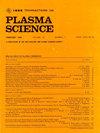Effect of Nanosecond Pulse Parameters on Plasma Characteristics and Radical Concentrations in Water Cathodes
IF 1.5
4区 物理与天体物理
Q3 PHYSICS, FLUIDS & PLASMAS
引用次数: 0
Abstract
Nanosecond pulsed plasma is a potential technology for wastewater treatment due to its high efficiency in driving plasma. In this article, a miniature needle water cathodes discharge structure based on the printed circuit board (PCB) technology is designed to achieve efficient plasma generation. The development process of plasma under nanosecond pulses was investigated, and the effects of pulse parameters on radical concentration, plasma temperature, and electron density were analyzed. In short-gap water cathode configurations, the initial tens of nanoseconds of the pulse dominate the optical signals. Initial secondary streamers span the entire gas gap. The absence of the纳秒脉冲参数对水阴极等离子体特性和自由基浓度的影响
纳秒脉冲等离子体驱动效率高,是一种很有潜力的污水处理技术。本文设计了一种基于印刷电路板(PCB)技术的微型针状水阴极放电结构,以实现高效等离子体的产生。研究了纳秒脉冲作用下等离子体的发展过程,分析了脉冲参数对自由基浓度、等离子体温度和电子密度的影响。在短间隙水阴极结构中,最初的几十纳秒脉冲支配着光信号。最初的二次拖缆横跨整个气隙。$\ mathm {H}_{\alpha}$发射的缺失和OH(A-X)的延迟出现表明OH主要是通过分子反应而不是电子冲击解离产生的。短脉冲宽度和短上升时间有利于自由基浓度和电子密度的有效产生。电压振幅和重复频率的增加增强了电子密度的不均匀性,但由于等离子体体积的膨胀而降低了平均电子密度。高压振幅也会提高自由基浓度和等离子体温度。重复频率的增加促进了背景气体中的能量沉积,使等离子体温度升高,导致放电更强,自由基产率增加。
本文章由计算机程序翻译,如有差异,请以英文原文为准。
求助全文
约1分钟内获得全文
求助全文
来源期刊

IEEE Transactions on Plasma Science
物理-物理:流体与等离子体
CiteScore
3.00
自引率
20.00%
发文量
538
审稿时长
3.8 months
期刊介绍:
The scope covers all aspects of the theory and application of plasma science. It includes the following areas: magnetohydrodynamics; thermionics and plasma diodes; basic plasma phenomena; gaseous electronics; microwave/plasma interaction; electron, ion, and plasma sources; space plasmas; intense electron and ion beams; laser-plasma interactions; plasma diagnostics; plasma chemistry and processing; solid-state plasmas; plasma heating; plasma for controlled fusion research; high energy density plasmas; industrial/commercial applications of plasma physics; plasma waves and instabilities; and high power microwave and submillimeter wave generation.
 求助内容:
求助内容: 应助结果提醒方式:
应助结果提醒方式:


